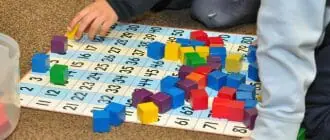Over the years I have noticed one major issue with the chairs students use in the class: they are terrible for sitting in. Part of being able to learn well is being comfortable, but the hard metal or plastic chairs most schools offer to kids is unpleasant and can make focusing and learning more difficult.

Kids complain about back pain, neck pain, and they almost always have bad posture as they try to make their seats more bearable. By changing up the types of chairs and seating in your classroom, you can create a more welcoming learning environment and improve the comfort levels of your students.
What is flexible seating?
 Flexible seating, also called non-traditional or alternative seating, is basically any furniture that does not involve the traditional desk and chair aspect of classrooms. It can include bean bags, yoga balls, bungee chairs, standing desks, pillows, couches, or just sitting on rugs on the floor. The idea of flexible seating is a fairly new movement, but many educators are hopping on board with it because they have seen great results from their students.
Flexible seating, also called non-traditional or alternative seating, is basically any furniture that does not involve the traditional desk and chair aspect of classrooms. It can include bean bags, yoga balls, bungee chairs, standing desks, pillows, couches, or just sitting on rugs on the floor. The idea of flexible seating is a fairly new movement, but many educators are hopping on board with it because they have seen great results from their students.
In an article titled “How Teachers Use Alternative Seating to Engage Students”, one teacher interviewed said she no longer had any desks in her classroom. Kids are able to sit basically anywhere, and they can use clipboards or computer trays if they need a hard surface to write or put their computers. Of course, the success of flexible seating depends on the teacher and students working together, but it is helping re-route the traditional idea of sitting still in neat rows of desks all day.
Benefits of Flexible Seating
Blood flow
Sitting anywhere allows kids to move their legs, bounce, and even stand up easily if they need to. Traditional classrooms are meant for students to sit for extended periods of time without moving much.

This research is based on Bloom’s Taxonomy
Source:The Effect of Movement on Cognitive Performance
A study called “The Effects of Movement on Cognitive Performance” showed that when students walked for ten minutes before taking a series of tests, they performed better. Movement simply allows more blood to flow to the brain, which brings oxygen to the tissues. This keeps students feeling more awake and ready to focus, and flexible seating is much better at this than boring old chairs and desks.
Kids are more collaborative
When students sit in forward-facing rows and blocks of desks, they usually do not feel encouraged to talk and work together on things. In fact, many classrooms are set up to intentionally stop kids from chatting during class time. When kids are able to sit in a more open setting, they are more willing to talk to all of the people around them and ask for help when they need it.
The idea of students talking during class might seem like a teacher’s worst nightmare, but when kids know they have a certain amount of time for collaboration and sharing, in my experience they often are quieter when I’m talking.
Better focus for kids with ADHD

For kids with hyperactivity disorders, sitting still in a hard chair all day can be even more torturous than usual. In the past, the way to deal with hyperactivity was to punish the child and keep him or her quiet. Instead of trying to force them to sit still all day, embrace the need to move.
Swivel chairs, yoga balls, and standings desks are all great options. Kids who need to keep moving are able without causing too much distraction, which allows better learning time for everyone.
Increased student engagement
A study titled “Flexible Seating Influencing Student Engagement” found that when 23 students in a classroom were asked to rate their level of engagement in different types of seating, 78% said they were highly engaged in a tall table while only 52% said they were highly engaged at a traditional desk and chair. The wiggle seat and short desk were the next highest, with 61% of students saying that they felt highly engaged at both of these settings.
| Seating Options | Percent of High Engagement | Average Engagement Score |
|---|---|---|
| Traditional Desk and Chair | 52% | 2.43 |
| Yoga Ball | 35% | 2.17 |
| Standing Table | 30% | 2.00 |
| Low Table | 61% | 2.57 |
| Wiggle Seat | 61% | 2.52 |
| Tall Table | 78% | 2.78 |
| Round Chair | 48% | 2.35 |
Source: Flexible Seating Influencing Student Engagement
The most impressive part of the research is that these kids were able to identify for themselves that they felt more focused when not sitting in hard chairs, meaning that there really is something to the flexible seating option. When kids are comfortable and relaxed, listening is easier and there is less focus on how uncomfortable traditional seats can be.
Improved test scores

Learning is different for each child in a classroom and having varied types of seating can be beneficial to the learning styles of everyone. A study of primary schools in the UK looked at three different categories of creating a more welcoming class environment. One of these categories was individualization, which included different types of seating in the classroom and was responsible for 28% of increased student engagement. Of course, teachers still need to be working hard to help their students but having a more flexible classroom design can be hugely beneficial for student progress.
Practice with decision-making
When a classroom is full of different seating options, kids can practice choosing where they want to sit. They can weigh the pros and cons of each style and see what they like best. According to the Center for Parent Information and Resources, including young kids often in small decisions can have positive impacts on their choices later in life. Letting kids pick where they sit isn’t a huge or stressful decision, but it is good practice for the future. Learning to become decisive now can transfer over to adulthood and become a great skill.

More on-task time
Research called “Alternative Seating and Students’ Perceptions: Implications for the Learning Environment”, conducted on the effect of an “o” cushion on the length of time students were on-task doing their math work in class found that when students sat on the “o” cushion, there was a significant increase in the amount of time actually on-task. When hours in a school day are already so limited, all teachers are looking for ways to increase productivity in their students, and flexible seating is a great way to do this.
Improved physical health
A study that measured the effects of sitting on young girls found that three hours of uninterrupted sitting caused a 33% reduction in vascular function. Basically, their veins and arteries were working at only 2/3 of what they should have been able to do.
There is also evidence that long periods of sitting can lead to weight gain, anxiety and depression, and possibly even some cancers, although the research for this is limited. School days are often between six and eight hours long, so if young kids are sitting still for even half of that day, they risk dealing with some serious health problems in the future. By sitting in seats that encourage more movement, kids can have a healthier future to look forward to.
Students prefer it
Overall, kids are the ones that matter in the classroom, and they almost always prefer comfortable, open seating compared to their normal desks. One teacher, Nichole Murray from California, conducted a survey to see how her students liked the flexible seating in her class.

Out of 143 responses, the majority of the students (54.5%) said that they strongly agreed they enjoyed picking a seat each day. All of the results showed a positive response to the change, which is the most important part of switching to flexible seating.
Excitement to be in class
Although there really isn’t research available for this one, as I teacher the difference is noticeable. When the classroom is fun and welcoming, kids want to be there. For younger kids and even pre-teens, you can use flexible seating as a type of reward.
If you notice that a student is listening particularly well or working hard in class, you can give them the chance to choose a fun seat for the week. Even if not all of the chairs in the class are comfortable and fun, a special spot is always exciting. When kids have the opportunity to be rewarded and can look forward to something small every day, coming to school doesn’t seem as awful for some kids.
Cons of Flexible Seating
Increased opportunity for cheating
For older students, cheating is harder to regulate. If they’re sitting in diverse spaces throughout the classroom, monitoring cheating on tests is even more difficult than normal.
The Josephson Institute Center for Youth Ethics surveyed 43,000 high school students and 59% of those kids said they had cheated on a test at least once in the past year. While cheating and plagiarism are never ok, almost everyone does it from time to time, and bean bag chairs and standing desks might make cheating easier in some ways.

Falling asleep
When kids settle into a comfy bean bag chair or stack of pillows, they might be more encouraged to fall asleep. Although it’s definitely still possible for students to sleep in a traditional desk and chair, alternative seating makes it even easier. Some students tend to fall asleep more than others too, which means they would constantly be missing important lessons.
Kids become possessive
I don’t know exactly why, but students always seem to find a place in the room that becomes theirs within a few weeks. Even if they’re allowed to pick a new seat every day, kids generally want their own spot. College students at Penn State noticed this phenomenon too.
A professor of psychology, Karen Gasper, said her theory is that the biggest factor is people like the familiar feeling of having the same seat each day, and changing that can be a little chaotic. If students don’t have a seating chart, they’ll settle into a spot anyway, which kind of defeats the purpose of flexible seating. Plus, young kids might start arguments over a highly desired spot if the same student takes it all the time.

Cost
While there are obvious ways to cut costs of classroom furniture, trying to pay for completely new seating can add up fast. A “Teacher Spending Survey” in 2018 found that 96% of teachers used their own money to buy supplies for their classroom, which was an average cost of 740 dollars per year.
Asking teachers to pay out-of-pocket for several couches or yoga balls isn’t fair, but school districts also would be unlikely to fork over the money for comfy new furniture. Most schools supply the basic desks and chairs that a class needs, but yoga balls and wobble chairs aren’t normally part of this budget. If you want to convert your class to flexible seating, you may need to save up for a few school years before you can afford to redecorate.
Difficult to clean
If you include couches in your new flexible classroom, you have to be vigilant. While hard desks and chairs are easy to wipe down with disinfectant, cushions and pillows get pretty gross. Charles Gerba, a hygiene expert, studied couch cushions and found that they are some of the most bacteria-filled places in a house. You can always do your best to clean classroom furniture, but mostly it will often be pretty nasty.
What’s the Bottom Line?
The jury is still out on the idea of flexible seating, but overall, it has positively impacted both teachers and students. The old ways of coming to school, sitting still in neat rows, and listening silently to the teacher are going away as we finally realize that learning happens in many different ways. Part of being a teacher is learning to adapt to everything your students throw at you, and if making your classroom more comfortable is one way to do that, there’s little reason not to.
If you’re looking for information about other ways you can make your classroom more flexible, you can read this article about tablets in the class, learn about video lectures, or look at these examples of teaching portfolio examples.
- How Teachers Use Alternative Seating to Engage Students
https://www.parenttoday.org/how-teachers-use-alternative-seating-to-engage-students/ - The Effect of Movement on Cognitive Performance
https://www.ncbi.nlm.nih.gov/pmc/articles/PMC5919946/ - Reflections on Shifting to a Flexible Classroom
https://www.edutopia.org/article/reflections-shifting-flexible-classroom - 17 Ways to Help Students With ADHD Concentrate
https://www.edutopia.org/discussion/17-ways-help-students-adhd-fidget - Flexible Seating Influencing Student Engagement
https://nwcommons.nwciowa.edu/cgi/viewcontent.cgi?article=1055&context=education_masters - Flexible Classrooms: Research Is Scarce, But Promising
https://www.edutopia.org/article/flexible-classrooms-research-scarce-promising - Involving Your Child in the Decision-Making Process
https://www.parentcenterhub.org/involving-your-child-in-the-decision-making-process/ - Alternative Seating and Students’ Perceptions: Implications for the Learning Environment
https://files.eric.ed.gov/fulltext/EJ1194561.pdf - Impact of Prolonged Sitting on Vascular Function in Young Girls
https://www.ncbi.nlm.nih.gov/pubmed/26370881 - Flexible Seating Survey Results by Nichole Murray
https://drive.google.com/file/d/0B8zrVRogrd6lRnVjcHZhOC0tcU0/view - Academic Integrity in High School
https://www.plagiarism.org/article/plagiarism-facts-and-stats - Do Flexible Classrooms Really Work?
https://www.theedadvocate.org/do-flexible-classrooms-really-work/ - Have you ever had your ‘assigned’ seat stolen? Turns out, you’re not the only one at Penn State
https://www.collegian.psu.edu/news/campus/article_ee6532fc-1d9d-11e8-a50e-638a248690f4.html - AdoptAClassroom.org 2018 Teacher Survey on Classroom Spending
https://www.adoptaclassroom.org/2018/08/19/adoptaclassroom-org-2018-teacher-survey-on-classroom-spending/?gclid=CjwKCAjw7LX0BRBiEiwA__gNw7Y-BbVvw7QXIMc7dclQj1BGUIClm5425ykFC–MSDB3UTypbsi7dxoCAHUQAvD_BwE - 7 of the dirtiest places in the average home
https://www.mnn.com/health/healthy-spaces/stories/dr-germs-gross-out-tour-of-a-typical-home
Last Updated on July 18, 2022 by Emily
- Facebook9
- Twitter21
- Pinterest67
- 97shares




